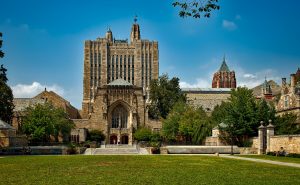
Yale University has announced that it will discontinue a popular art course. It is one more nail in the coffin of a classical education that once dominated academia.
The course in question is called “Introduction to Art History: Renaissance to the Present.” It consists of a review of art starting at 1300 down to the present day. Most of the art is of European origin. Students also have access to the considerable resources of Yale’s Art Gallery to supplement the course lectures.
Once taken, students will have acquired a general knowledge of art that used to be part of having culture.
The Quest for Popularity
The course is popular. When news spread that this semester would be the last one, over 400 students tried to sign up, even though enrollment is capped at 300, according to the Yale News.
Courses like this one are not supposed to be popular anymore. Imagine three hundred students in an auditorium, while a professor talks about art while displaying slides. This process goes on for three hours a week over fifteen weeks. According to the believers in the ideology of John Dewey, students in such settings are rapidly bored. Progressive educationists argue that they learn nothing.
Help Remove Jesus Toilet Lid on Amazon
The purveyors of such ideas must have never taken courses from skilled lecturers who thoroughly know their disciplines. In such a class, hours pass like minutes. When leaving, students crowd around the professor to ask more questions. Stories told by these professors take on a kind of mythical status. Often, students will tell the stories – complete with the professor’s vocal intonations – decades after graduation.
The Loss of Traditional Curriculum
The classical university curriculum consisted of the trivium and the quadrivium. The trivium consists of the arts of words – grammar, logic, and rhetoric. The quadrivium – arithmetic, astronomy, music, and geometry – deal with the arts of numbers. Centuries ago, natural sciences, fine arts, and history joined this framework. A Bachelor of the Arts degree meant the person was equipped with knowledge of the world and its culture.
Such general knowledge lost favor after World War II. College became a more “democratic” experience, in that people from a broader set of backgrounds were encouraged to gain a higher education. For many of these new students, the years in college had to “pay off.” They looked for the specific skills of a chosen profession. Accounting, business administration, education, pre-med, pre-law, and other fields of study entered the curriculum. Universities began to look like advanced trade schools for such professions.
Many of the old courses remained. The academic deans understood that students might intend to become accountants but still believed that all should be familiar with the language of the learned.
Satanic Christ Porn-blasphemy at Walmart — Sign Petition
Educational Revolutionaries
The sixties changed everything. During the “decade of relevance,” students resisted the idea that they should study any subject simply because they were told to do so by the university. They protested, and the universities surrendered.
Then came multiculturalism and the revolt against Western Civilization courses. Students argued that Western culture was inferior to those of Asia or Africa. The issue had nothing to do with being prevented from studying about Asia or Africa. The spirit of the revolutionaries objected to being required to consider anything that did not interest them.
Thus, courses in Shakespeare’s tragedies morphed into studies of the “poetry” of John Lennon and Bob Dylan. Any whiff of Christianity only made the rejection louder and less coherent
How Panera’s Socialist Bread Ruined Company
As the third decade of the twenty-first-century dawns, the traditional holdouts are few and far between – like Art History at Yale.
The Blind Leading the Blind
Unfortunately, even these last three hundred students will receive an already diluted course. Professor Tim Barringer, the course’s instructor, informed Yale News, “I want all Yale students… to have access to and feel confident analyzing and enjoying the core works of the Western tradition. But I don’t mistake a history of European painting for the history of art in all places.”
Nor does Prof. Barringer wish to be seen as the expert in the room. “I’m really looking forward to seeing what works the students come up with to counteract or undermine my own narratives.” Once again, as happens so often in the halls of modern academe, the facts and expert analysis will lose out to half-formed opinions based on minuscule amounts of evidence.
[like url=https://www.facebook.com/ReturnToOrder.org]
The Prof. Berringers of the world do not understand is that the public at large is beginning to question the value of university education. Many students may be lazy – but they know when they are cheated. What they learn does not correspond to the burden of their massive student debt and lost time.
The Path Out of Confusion
A proper student-teacher relationship implies that the teacher has truths and information that the student needs. The teacher’s role is to break down this content into pieces that the student can understand. The student’s responsibility is to search for and receive the truth from the professor for future use.
Unfortunately, modern schools, at every level, have lost this simple concept. Today’s educational fads and trends no longer inspire the students to search for the truth.
Fortunately, God has given everyone an intelligence that naturally seeks truth, along with its companions, goodness, and beauty. Human souls search for them until they are satisfied. Modern intellectual fads are doomed to join the ash heap of history since they are ridiculous ideas that go nowhere. Even the people at Yale might figure it out someday.


